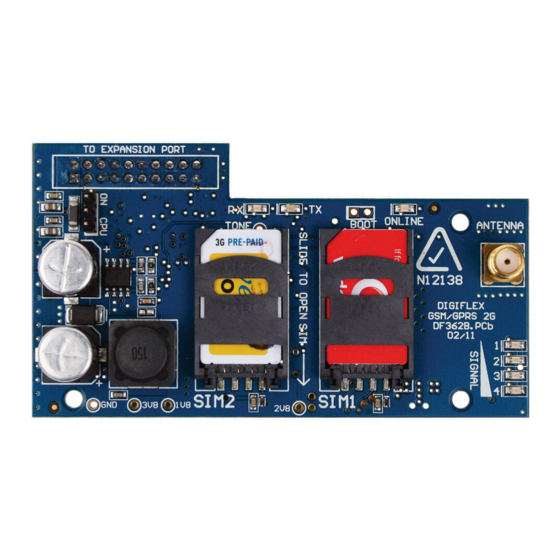- ページ 2
コントロールユニット Digiflex CM743のPDF インストーラー用リファレンス・マニュアルをオンラインで閲覧またはダウンロードできます。Digiflex CM743 4 ページ。 2g radio module

Introduction
The CM743 2G radio module allows you to interface
compatible security control panels to the GSM/GPRS /
SMS network providing a high reliability primary or
backup reporting path.
The unit is designed to plug onto the main control panel
with the supplied antenna mounting onto the metal
cabinet.
Module Compatibility
Panels Supported
Vision-X
Getting Started
There are four main steps required to configure the
CM743 for reporting to the control room. The instruc-
tions assume that you already have purchased a SIM
card and that the card has been charged with credit and
activated on the network if necessary.
1. Install the CM743 hardware on the control panel.
2. Install the antenna.
3. Configure the module's features and parameters.
4. Configure the control panel for reporting.
Step 1 - Installing the Radio Module
Ensure that the panel is powered off before proceeding.
Plug the 3 short plastic standoffs into the module and
then plug it onto the Expansion Port header pins on the
panel as shown in. If you are connecting the CM743 to a
panel which also has a CM101 Voice Module fitted then
you should use the longer standoffs from the HW750
Riser Kit.
Install the SIM card into the SIM 1 card position.
Page
2
CM743 2G Radio Module
Version
2.12
P/N: CM743IRG Rev 1.6
Step 2 - Installing the Antenna
Remove the knockout in the top of the cabinet and pass
the antenna lead through the hole ensuring the antenna
is on the outside of the cabinet. Screw the lead to the
socket on the radio module before power the panel.
Do not fix the antenna in place at this stage.
Step 3 - Configuring The Module
Once powered the radio will attempt to connect to the
network. This may take up to a minute to complete.
During this time the online indicator on the module will
be on solid. Once the radio has registered the online in-
dicator will begin to flash and the signal strength indica-
tors will show the current signal condition.
Experiment with the position of the antenna to find the
best signal strength before fixing it in place.
Step 4 - Configuring The Panel Reporting
Reporting configuration will vary depending on the
required options and whether or not the GSM module is
to be used as the primary or secondary reporting route.
Configure the required reporting formats in MENU 5-4-0
and 5-4-1. The system can be configured to report to
the base in CID and also to selected phone numbers via
SMS, or to the base in CID via PSTN line and then CID via
GSM if the PSTN line is cut.
All reporting scenarios are configured by varying the
programming of the reporting format and reporting
routes configurations options.
Module Indicators
The module includes 7 led indicators which are used to
show status and signal strength. See table below.
Module Indicators
Indicator
TX
Module Transmitting Data (Tx Data In CID)
RX
Module Receiving Data (Kiss Off In CID)
ON Steady = Not Registered On Network
Online
Pulsing = Registered On Network
Signal 1
Signal strength indicators show relative
Signal 2
signal level at the radio. Signal indicator 1
on indicates weak signal and all 4 indicators
Signal 3
on indicates stronger signal strength.
Signal 4
E&OE
Meaning
Copyright © 2014
